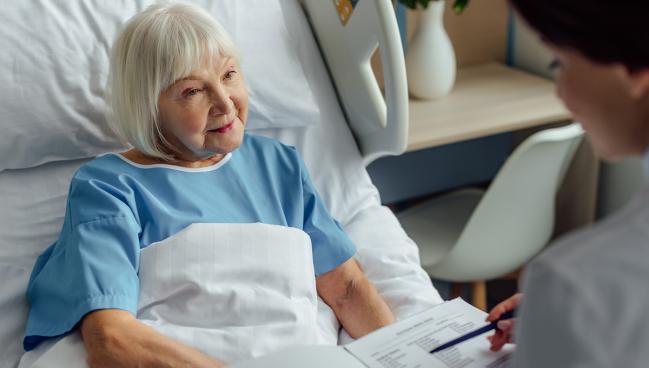Sudden Deaths After Acute MI Have Dropped, but Early Weeks Remain Risky
Two trials conducted 20 years apart affirm the benefits of GDMT in patients with LV dysfunction or pulmonary congestion.

Though rates of sudden cardiac death (SCD) after acute MI in patients with pulmonary congestion or significant left ventricular (LV) dysfunction have dropped by two- to threefold over the last two decades, the risk of these events has remained high within the first month, according to new data from the VALIANT and PARADISE-MI trials.
The results confirm that advances in guideline directed medical therapy (GDMT) and PCI have been successful in improving patient outcomes following MI but also suggest that use of implantable cardiovascular defibrillators (ICDs) may no longer be appropriate for primary prevention, the study’s authors say.
“It confirmed the expectation that rates of sudden death have reduced over time—that much I don't think is a surprise. What stood out was the magnitude to which rates of sudden death had reduced over time,” lead author James P. Curtain, MBBS (University of Glasgow, Scotland), told TCTMD. “What was really marked was the difference in rates between trials and just the fact that sudden death rates had reduced by two- to three-fold between the two trials that were conducted 20 years apart.”
Two Trials
For the study, published online this week in JAMA Cariology, Curtain and colleagues analyzed data from two trials of acute MI patients with pulmonary congestion and/or LVEF ≤ 40% treated with renin-angiotensin-aldosterone system (RAAS) blockers:
- VALIANT: 14,703 patients (mean age 64.8 years; 31.1% female) enrolled between 1998 and 2001 randomized to valsartan, captopril, or both
- PARADISE-MI: 5,661 patients (mean age 63.7 years; 24.1% female) enrolled between 2016 and 2020 randomized to sacubitril/valsartan (Entresto; Novartis) or ramipril
Compared with patients enrolled in the VALIANT trial, those in PARADISE-MI had lower systolic BP, higher body mass index, higher eGFR level, and a higher proportion of Killip class I/III. They were also less likely to have had a prior stroke or CABG but more likely to have diabetes, hypertension, and history of PCI. Additionally, more patients in PARADISE-MI than VALIANT were treated with PCI for their qualifying event (88% vs 23.4%) and more received beta-blockers (85.3% vs 69.1%), statins (94.9% vs 32.3%), and mineralocorticoid receptor antagonists (41.3% vs 9.0%).
The rates of all-cause death in the VALIANT and PARADISE-MI trials were 19.7% over a median of 24.7 months and 8.0% over a median of 22.2 months, respectively. These were highest for both trials within the first month—at 21.3% in VALIANT and 23.3% in PARADISE-MI—with steady declines after.
While 7.4% of the VALIANT cohort experienced SCD or resuscitated cardiac arrest (RCA), this number dropped to 2.6% in PARADISE-MI. However, each trial had similarly high percentages of these events reported in the first month after MI (21.2% vs 29.7%).
Curtain acknowledged the limited generalizability of the study findings given that they were based on patients enrolled in clinical trials. But, he stressed, they are strengthened by being international and “consistent with audit data from various national registries that outcomes have been improving over time, particularly with the development of networks of care facilitating primary PCI in patients who have had STEMI.”
He said there remain patient cohorts who are still at “substantial risk” of sudden death; however, it’s clear that contemporary treatments have “really remarkably reduced” the rates of both all-cause and sudden death over time.
A key question is whether it’s still appropriate, given the new findings, to implant an ICD in somebody at risk for SCD. “My sense is that the way forward here is to first try to identify patients who are most at risk of tachyarrhythmic death . . . and who would gain the most from a defibrillator, and [then] find ways to try and distinguish, if possible, these people from people who are at risk of nontachyarrhythmic death,” he suggested.
Curtain also called for the development and adoption of novel noninvasive technologies that could be used as a bridge in the care of patients immediately after MI. “If we can get those few things done properly and demonstrate effectiveness in any interventions that are developed,” he added, “we’ll have done what we set out to do.”
New ICD Thinking
In an accompanying editor’s note, Gregg C. Fonarow, MD (University of California, Los Angeles), Kristen K. Patton, MD (University of Washington, Seattle), and Clyde W. Yancy, MD (Northwestern University, Chicago, IL), agree that substantial progress has been made for these patients.
“Taken together, the relentless pursuit of best evidence to guide care for LV dysfunction and achieve rapid reperfusion and the emergence of highly effective and post-MI and ambulatory heart failure therapies now change the framework as we manage the risk of SCD,” they write, adding that the new data might “prompt an opportunity for more personalized application of ICD therapy.”
Elsayed Z. Soliman, MD (Wake Forest School of Medicine), who was not involved in the study, similarly told TCTMD the study “definitely challenges the current thinking of using ICD for primary prevention.” Moreover, he continued, “it is time to refine the indications we have for using ICDs for primary prevention and to refine the use of ICDs in general.”
Because there is a proportion of SCD that happens in the general population, Soliman said, more-effective risk stratification—potentially making use of artificial intelligence and machine learning to do so—and prevention methods are needed generally. “Those people may also need ICDs, and we don't really consider them,” he said.
Yael L. Maxwell is Senior Medical Journalist for TCTMD and Section Editor of TCTMD's Fellows Forum. She served as the inaugural…
Read Full BioSources
Curtain JP, Pfeffer MA, Braunwald E, et al. Rates of sudden death after myocardial infarction—insights from the VALIANT and PARADISE-MI trials. JAMA Cardiol. 2024;Epub ahead of print.
Fonarow GC, Patton KK, Yancy CW. Changing the frame of post-AMI left ventricular dysfunction sudden cardiac death, a diminishing complication. JAMA Cardiol. 2024;Epub ahead of print.
Disclosures
- Curtain reports receiving consulting fees from FIRE1.
- Fonarow reports receiving personal fees from Abbott Laboratories, Amgen, AstraZeneca, Bayer, Boehringer Ingelheim, Cytokinetics, Edwards, Eli Lilly, Janssen, Johnson & Johnson, Medtronic, Merck, Novartis, and Pfizer.
- Patton, Yancy, and Soliman report no relevant conflicts of interest.





Comments